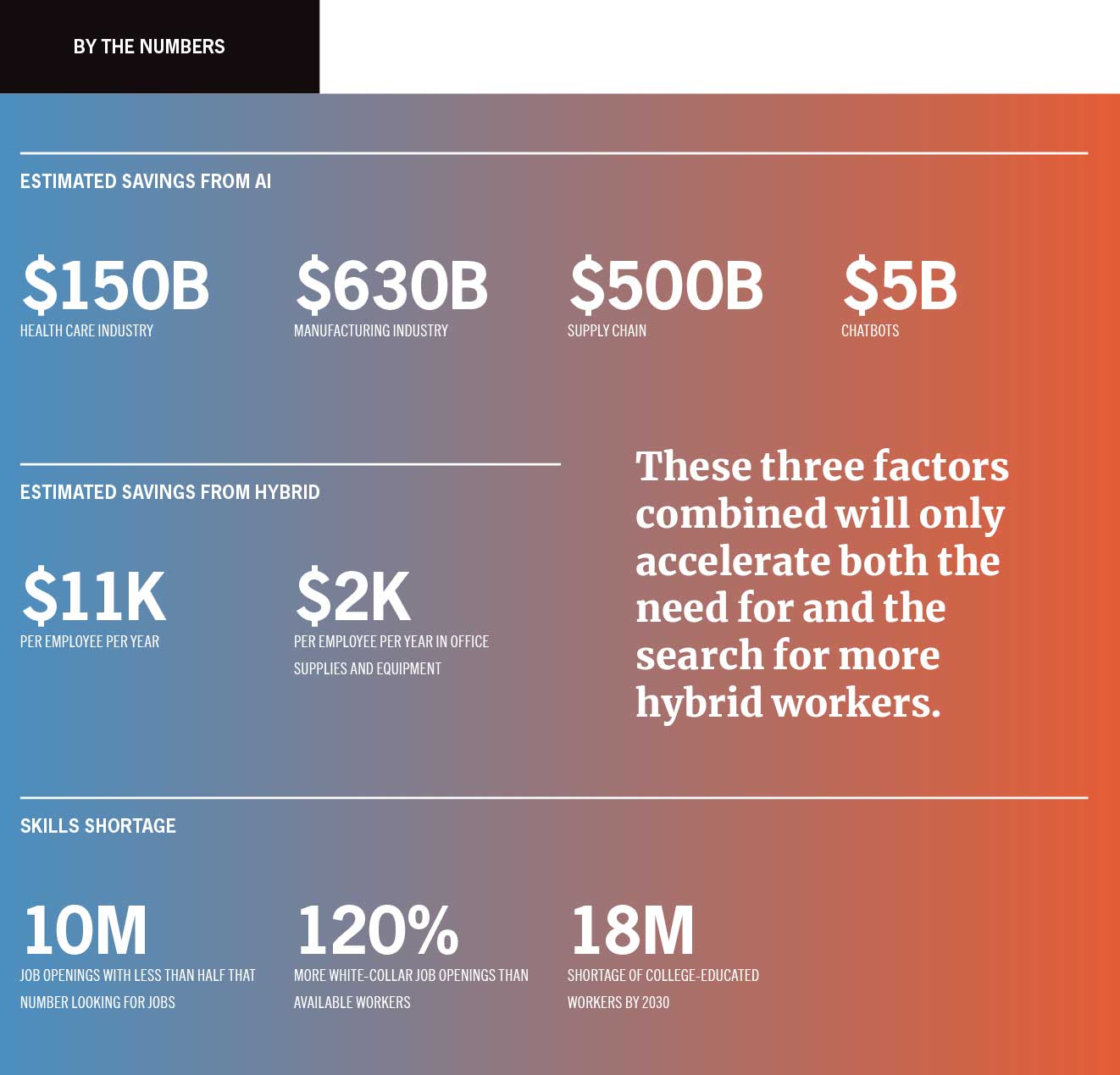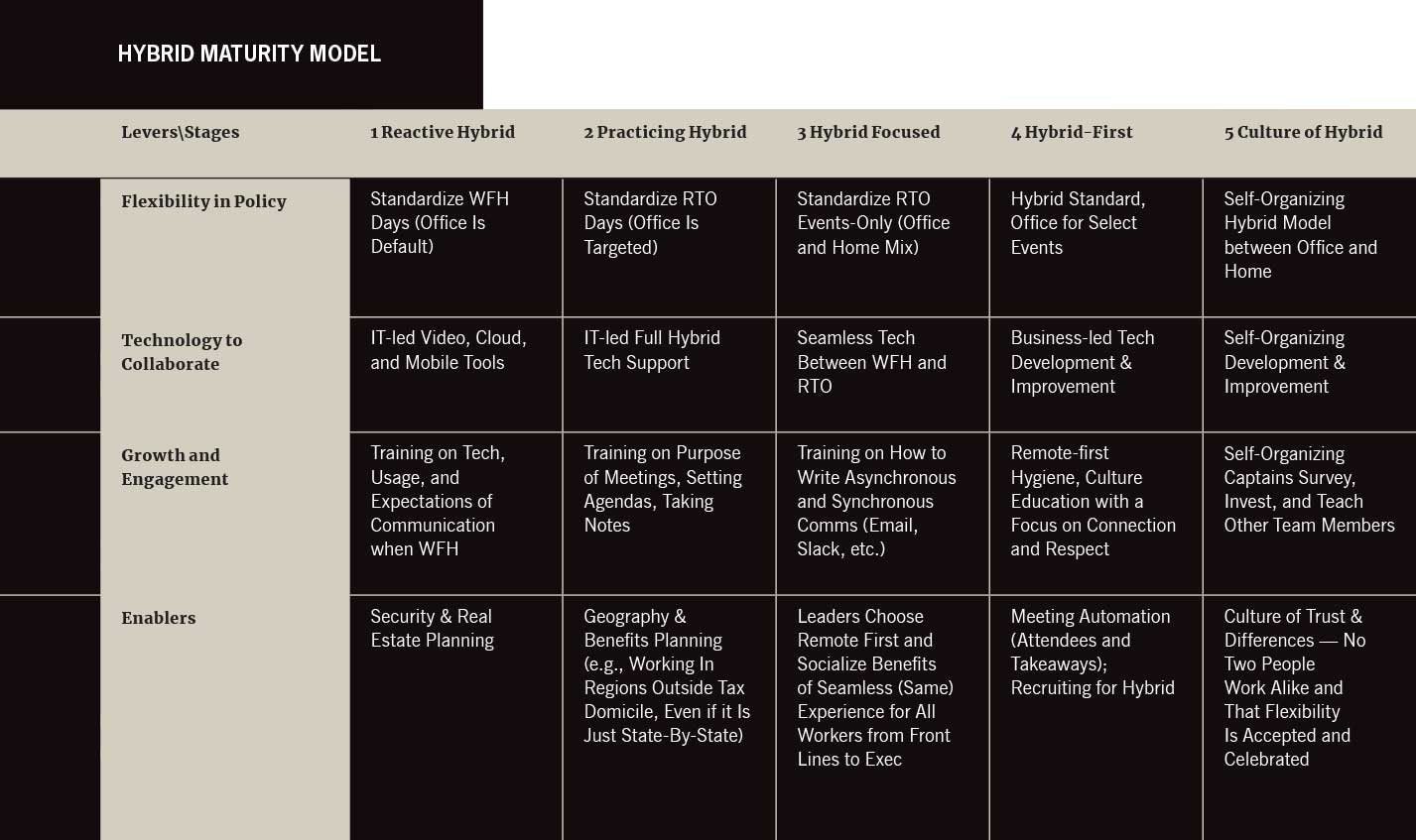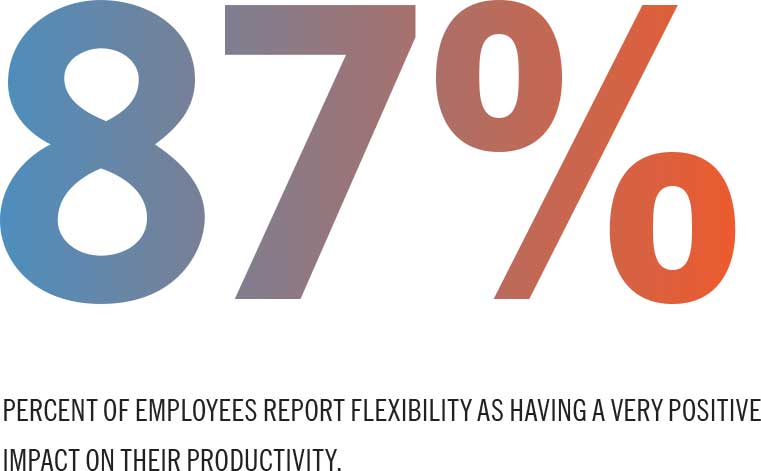Here is the good news: We are post-pandemic, a mix of in-office and at-home is sticking, and hybrid work is effective. Gallup states that 2 of every 3 hybrid workers are more efficient, and Microsoft reports that nearly 9 in 10 hybrid workers are more productive.
Here is the bad news: Not every manager agrees with those facts. Microsoft calls this “management paranoia,” where leaders do not believe someone is working unless they see them working in person. And that paranoia is not going away. It is only going to accelerate as we add more and more jobs that incorporate hybrid work.
We shouldn’t expect to see hybrid work leveling off; we should expect to see even more hybrid workers. In fact, three things will accelerate the transformation to an all-hybrid world: increased utilization of artificial intelligence (AI), the inevitable need for cost savings, and ongoing skills shortages. Let’s examine each accelerator.
1. AI Potential
With AI tools being used for years and now more widely available for free, businesses are finally harnessing AI-assisted efficiency. With AI, you can get the technology for free if you’re willing to train it. Would any of these AI use cases come as a surprise to you?
- AI speech recognition to detect both attendance and sentiment of attendees in meetings.
- AI virtual assistants (aka chatbots) to guess an approximate answer to your question, any question you have, at any time.
- AI predictive analytics to evaluate customers, predict demand, and even detect fraud.
- AI image recognition software to take data from one location (i.e., paper) and re-enter it into one or multiple systems, with live rectification of errors and flagging of uncertain entries.
All those technologies have been here for over a decade, so imagine what we have coming! The potential impact on AI and directly on workers is huge. Here are some of the estimated savings: Accenture estimates $150 billion in health care industry savings, McKinsey & Company estimates $630 billion in manufacturing industry savings, Deloitte estimates $500 billion in supply chain savings, Juniper Research estimates savings from chatbots alone are $8 billion, and PricewaterhouseCoopers estimates the overall impact of AI could be $15.7 trillion by 2030.

2. (Un)realized Cost Savings
Cost savings for hybrid work usually start simple, with office expenses. Lower operating costs are a reality when you have fewer workers and less demand for the workstations and amenities needed for a five-day-a-week occupied office. Some companies have refused to reduce these costs because they want to reallocate pre-pandemic costs and encourage in-person collaboration with incentives, food, and activities.
The temptation to lower real estate costs, however, won’t be staved off forever. Even though absenteeism and turnover go down with flexible work policies, which save money in terms of recruitment and training, unoccupied space is still a cost to the business. Any CFO with an eye toward annual savings goals will at least ask the question of what real estate costs can be saved.
Hybrid work savings have been estimated by several companies. Global Workplace Analytics estimates savings with hybrid at $11,000 per year per employee and SHRM (Society of Human Resources Management) estimates savings of $2,000 per employee per year for office supplies and equipment. Capturing these savings will be key, as will thinking about who the new hybrid workers will be in the future.
3. Ever-Increasing Skills Shortage
We have more jobs than workers according to the Bureau of Labor Statistics, where for the first time there were over 10 million job openings and less than half that number of workers looking for a job in early 2023. We understand there is a shortage of about 100,000 truckers and a shortage of 2 million manufacturing workers.
We also have fewer skilled workers than needed for white-collar work, with 120 percent more job openings than available workers, according to the Conference Board (0.8 unemployed college-educated workers per opening). McKinsey & Company estimates that we will be short 18 million college-educated workers by 2030.
These three factors combined will only accelerate both the need for and the search for more hybrid workers.
So, given this acceleration to hybrid work, what can we do about it?
The fundamentals of hybrid work have likely already been shared with you. The basic needs of hybrid work are a two-pronged approach of (1) setting up a two-to-three-day remote and two-to-three-day in-person policy with some guidelines around communication; and (2) arming employees with a solid toolset from technology vendors such as Microsoft and Slack with the appropriate training. If you haven’t already, your leadership team should reevaluate the meaning of productivity (read the article from the Fall 2022 Jabian Journal titled “The New Office Experience Is All About Relationships”).
But the most important step is making hybrid work a permanent part of your culture. This is often the most difficult step for leaders because they see hybrid as a temporary fad rather than a long-term reality. However, as we’ve discussed, hybrid is here to stay, and the expansion of hybrid will continue to accelerate.
The shortcut to hybrid culture is being a remote-first company. This is still rare and has been estimated to be relevant for less than 10 percent of white-collar workers. Remote-first operates under the presumption that people will never come into the office. However, for the other 90 percent of white-collar workers, there is a need to balance in-office time and at-home time. There is a spectrum of cultural maturity stages with hybrid work, from new to hybrid to a fully hybrid culture. This spectrum can be looked at through three lenses: policy, technology, and growth, with key enablers for each. Let’s dive deeper into the hybrid maturity model:

Stages of Flexibility in Policy
The first stage is to standardize when people can work from home. This defines allowed days at home, defaulting to in-office work. The next step is to standardize days at the office, meaning defaulting to work from home. These two options are an important distinction for what matters first to your company — defining the home as an exception or defining the office as the exception. The more developed your hybrid model becomes, the more the office is truly the exception and used for exceptional events, as in stage three. Then for stage four, the office isn’t really about events such as all-hands or key meetings, but the office is used for targeted collaboration such as getting multifunctional teams together on a big, new transformation. By this stage, teams are getting better at collaborating and innovating with mixed in-person and at-home team members (see sidebar on innovation). Finally, at stage five, a fully hybrid culture, teams have demonstrated competence in self-organizing and can leverage the office as needed, with no policy necessary because your workforce is grounded in trust. Imagine recruiters that say to prospective employees, “We trust you implicitly.” The key behind the first lever of policy is how much flexibility you are offering your people. Recall that flexibility is a key element of employee engagement, and Deloitte has published that 87 percent of employees report flexibility as having a very positive impact on their productivity. Flexibility matters!

Leading Innovation in a Hybrid World
Leaders have been concerned about productivity when they cannot see employees in the office. My personal mission is to get leaders to think in terms of measuring outcomes, which is more important than measuring output. So, for many leaders, productivity measured by widget throughput is not the best measure of success. See our article on the new productivity equation from the Fall 2022 Jabian Journal titled “The New Office Experience Is All About Relationships.”
There is a second big hurdle for leaders once they reframe productivity, and that hurdle is accepting a new method of innovation. Previously, leaders got used to a “freebie” where spontaneous interactions in the office lead to collaboration and partnerships. However, in a hybrid world, these interactions are often more forced than freely occurring. This has led leadership to begin doubting whether hybrid works for innovation. The truth: It does.
The key behind hybrid innovation is keeping social circles open across an organization. When team members feel isolated or excluded, which can become the norm for at-home workers, innovation can easily decrease. This is why the hybrid maturity model is so powerful. At each step of the way, we are considering the needs of team members to grow, enabled by technology and flexibility. Training is not a one-and-done but is provided at each stage to deepen hybrid maturity and ensure innovation.
The best science behind hybrid innovation comes from Ravi Gajendran and Aparna Joshi from the University of Illinois at Urbana-Champaign who found that leaders are the most responsible for innovation. The reason why leaders, and not team members, are most responsible is that as team dispersion increases, the relevance of leader-member communication increases.
Thus, if you want more innovation, arm your leaders with the ability to build relationships and communicate often. Managers who understand how to reduce psychological distance, that is, create a sense of belonging, will ensure your hybrid business succeeds at being innovative.
Hybrid Employee Engagement
Leaders often are concerned about hybrid harming employee engagement. While hybrid can have negative consequences — from losing connections to losing a fixed desk — each of the common negative impacts can be easily overcome.
Having spent years in a “hoteling” office where workspaces were reserved daily, I can personally tell you that the morning hunt is not fun. Trying to find a workspace that meets daily needs, whether that is related to quiet work or collaboration, is no easy task. Precious time is spent navigating ineffective systems with poor user interfaces. On top of that, hoteling can make employees feel like visitors rather than having a sense of belonging.
There is a simple fix: give people more control over the hoteling system. Enable weeklong bookings, give employees control over leaving personal items at the office, and ensure the most control for employees that want to spend the most time in the office. Additional best practices include the concept of “neighborhoods” where you have not only teams that work together but spaces that are similar such as quiet areas versus collaboration areas. Don’t forget the training that is part of the hybrid maturity model. People need training on keeping places clean and respecting the different needs of different neighborhoods.
Having the tools to do your job, such as having a workspace fit for purpose, is just one component of employee engagement. Employee engagement overall, most extensively studied by the Q12 (or Gallup 12), also involves relationships with supervisors, understanding purpose, and talking about progress and growth.
Bradford Bell, Kristie McAlpine, and N. Sharon Hill from Cornell, Rutgers, and George Washington Universities published compelling research in 2022 on what makes organizations, leaders, and employees work well in a virtual environment. They found an important link that directly tied success to businesses enabling self-managing teams and leaders to provide clear expectations and goals.
Engagement is a two-way street, and leaders have a key role in ensuring that team members have control over their workspace while receiving clear guidance. Hybrid is not a “set it and forget it” type of situation. Hybrid is a new way to manage with clearer expectations and more self-management, which is a win-win for modern workforces.
Stages of Technology to Collaborate
Along the way, technology is not just an enabler. A technology strategy is a must for hybrid to function properly. The IT team leads the charge by enabling basic tools at stage one and then considering full tech support at stage two. Be careful; technology can easily get caught in the measurement phase here (recall “management paranoia”) and must avoid the trap of over-indexing on false performance measures such as badge swipes or days in the office. Attendance measurements are for an untrusting and unproductive team. Measuring outcomes is more important than trying to track employees, but that doesn’t mean that you should avoid being clear that underperformance is unacceptable. Once a team is at stage three with reduced office time, all workers, especially a team with a mix of in-person and remote workers, need to have a seamless experience between their office setup and home setup. This means similar technology, simplified tools, and standards that prevent downtime and ensure high levels of uptime. This also likely means hoteling at the office to ensure hybrid is a success (see sidebar on hybrid employee engagement). At stage four the business will have learned enough about its needs to drive improvements. By stage five business teams are specifying their needs to IT fixing targeted issues such as audio concerns for mixed crowds and using better tools such as AI to identify speakers and ensure no one is left out of the conversation.
Stages of Growth and Engagement
Stage one of growth is simply training on communication channels, but stage two is how to best use those communication channels. That includes annual training on how to properly drive a meeting with a hybrid workforce that is a mix of at-home and in-the-office. Stage three takes that one step further and teaches your people how to handle different channels, at different times, with considerations for all types of workers, as your workforce becomes less reliant on the office and office technology to solve their communication needs. Then at stage four, culture education must be focused on a hybrid culture, acceptance at all levels, especially management, and hygiene factors (e.g., when and why office work is critical to the business, needs of different employees based on location, etc.) that are communicated clearly. Once stage four is mastered, progressing to stage five means self-organizing with captains within the organization who survey people for how to best optimize hybrid work and incorporate nascent tools such as AI and the metaverse. This requires having a budget for hybrid workers and investing in education, technology, and other refinements to ensure people continue to grow and stay engaged despite not always being in person.
Stages of Enablers
Along the way, several enablers are key for driving success and ensuring leadership buys into the hybrid model. This starts with remote security such as virtual private networks (VPNs) or multifactor authentication (MFA) and goes to the heart of remote work trust. Reactive real estate planning often occurs as well at stage one with trials for hoteling and other key cost management plans. Then at stage two, considerations for more remote workers are needed and HR planning for tax implications is essential to sustain a workforce that may not always work from the same geography. Being clear about expectations and implications is critical here. By stage three leaders need to demonstrate that they themselves are benefiting from the tools of working remotely and choosing remote more often than at the office. Frankly, leaders have already been receiving these benefits for some time as they have worked hybrid by traveling from office to office. Making this success story for leadership explicit is essential at stage three. Also, at this stage, a reimagined office comes in with a rationalized (cut down) real estate portfolio that is fit for purpose. By stage four, meetings are automated with attendee information and key takeaways automatically sent. This is where technology comes in to ensure that hybrid does not raise costs for the organization. By stage five, the culture celebrates on a monthly or more often basis a “culture of differences” where no two workers are the same, nor work the same, nor have the same schedules. This celebration and additional celebrations of hybrid successes cement hybrid culture.
One more piece of advice: Survey your employees. Give them what they need. You’ll hear early on they need support transitioning between the office and home. That may involve stipends or just IT support for setup depending on the role. As time goes on the support will evolve to enable us to be better at hybrid work, with clear meeting agendas with a stated purpose and notes taken related to outcomes. Once your company is fully hybrid then you have achieved full self-organization where budgets can be driven directly by business needs. The best part — if you just listen to your people, they can guide you each step of the way to enhance trust and deepen engagement.
